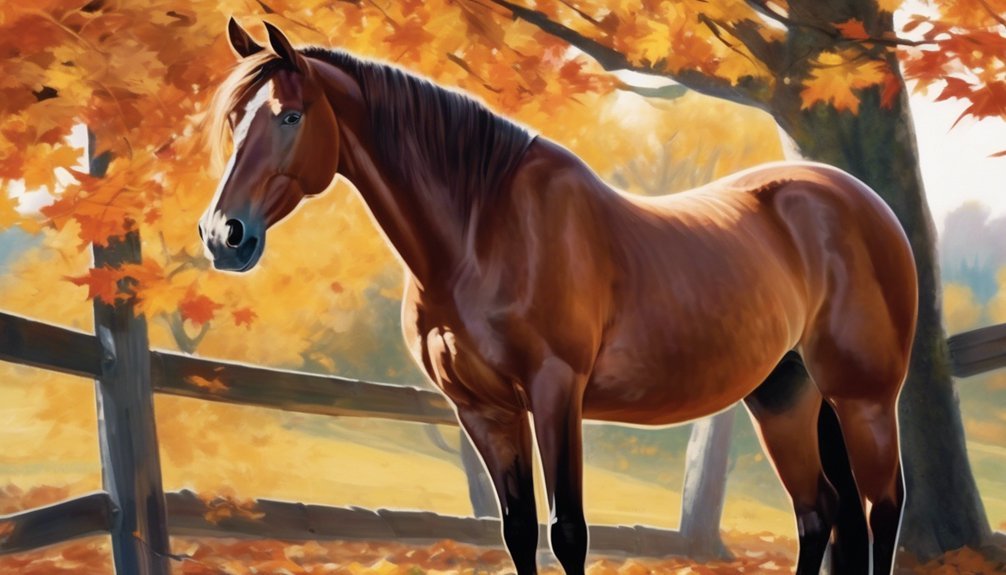
Horses undergo significant coat changes with the changing seasons, which can affect their overall health and appearance. Understanding these changes is crucial for maintaining your horse's coat in optimal condition. From grooming techniques to nutritional adjustments, each season requires specific strategies to support your horse's coat health. Are you prepared to implement these essential practices as the seasons shift?
Key Takeaways
- Monitor environmental factors like temperature and daylight, as they influence coat changes and shedding cycles.
- Increase grooming frequency during shedding seasons to promote skin health and remove loose hair.
- Adjust the horse's nutrition with supplements like biotin, omega fatty acids, and high-quality forage for optimal coat condition.
- Ensure proper shelter conditions, providing warmth and ventilation in winter and shade during summer to support coat health.
- Regularly check for skin irritations or parasites, especially during transitions, to maintain overall coat and skin health.
Understanding Seasonal Coat Changes

As the seasons shift, your horse's coat undergoes significant changes that are crucial to its health and well-being. Understanding coat cycles is essential, as they directly relate to environmental factors such as temperature, daylight, and humidity.
In spring and summer, your horse sheds its dense winter coat for a lighter one, allowing for better thermoregulation. Conversely, as autumn approaches, the thickening of the coat prepares your horse for colder weather.
Maintaining awareness of these cycles helps you provide optimal care, including adjusting nutrition and shelter. Keep an eye on your horse's coat condition, as it can indicate health issues if it doesn't transition properly.
Grooming Techniques for Winter
With winter's arrival, your horse's grooming routine becomes more important than ever. Start by carefully removing winter blankets, as this allows you to check for any skin issues or irritations.
Use winter grooming tools like a rubber curry comb to loosen dirt and debris, followed by a stiff-bristled brush to remove the loosened particles. Pay special attention to areas where sweat may accumulate, such as under the saddle and girth. A body brush can help distribute natural oils, promoting a healthy coat.
Don't forget to check the hooves, cleaning them thoroughly to prevent ice and dirt buildup. Regular grooming not only maintains your horse's coat but also strengthens your bond, ensuring they remain comfortable during the colder months.
Preparing for Summer Shedding

When temperatures rise and days grow longer, your horse will begin the natural process of shedding its winter coat.
To prepare for this transition, focus on increasing grooming sessions to match the shedding frequency. Regularly using a shedder or curry comb will help remove loose hair and promote healthy skin.
Ensure you're doing coat maintenance by checking for any skin irritations or parasites that can become more prevalent during this time. A clean, well-groomed coat not only looks good but also supports your horse's comfort as it sheds.
Nutritional Adjustments for Coat Health
To ensure your horse's coat remains healthy during shedding, it's essential to make appropriate nutritional adjustments. Focus on providing balanced nutrition that supports coat health.
Consider these key components:
- Vitamin supplements: Incorporate biotin and vitamin E to enhance coat strength and shine.
- Fatty acids: Include omega-3 and omega-6 fatty acids to promote hydration and reduce skin irritation.
- High-quality forage: Ensure access to nutrient-rich hay to support overall health and coat condition.
Regularly assess your horse's diet, adjusting as needed to meet their specific requirements.
Shelter Considerations for Different Seasons

Nutritional adjustments play a significant role in your horse's coat health, but shelter considerations are equally important throughout the year.
Different shelter types, such as barns, run-in sheds, or portable shelters, can significantly impact your horse's comfort and coat condition.
In winter, ensure your shelter is draft-free but allows for adequate ventilation; this helps prevent moisture buildup and promotes a healthy coat.
During summer, prioritize shade and airflow to keep your horse cool, as excessive heat can lead to stress and a dull coat.
Regularly check your shelter's condition, making necessary adjustments to maintain a safe and comfortable environment.
Your horse's well-being hinges on these considerations, enhancing their coat's natural beauty and overall health.
Managing Coat Shine and Health
A horse's coat reflects its overall health and vitality, making coat shine and condition crucial for both aesthetic and well-being reasons.
To maintain a healthy coat, focus on these key aspects:
- Proper nutrition: Ensure your horse's diet includes essential fatty acids and minerals.
- Regular grooming: Daily brushing stimulates the skin and distributes natural oils.
- Quality shine products: Use coat conditioning sprays or oils to enhance luster.
Investing time in these practices not only improves your horse's appearance but also promotes skin health.
When selecting shine products, choose those that are free from harsh chemicals to avoid skin irritation.
Recognizing Signs of Coat-Related Issues

How can you tell if your horse is experiencing coat-related issues? Pay close attention to changes in coat thickness and any signs of skin irritation. A healthy coat should feel smooth and be free of bald patches or excessive dandruff. Look for these indicators to gauge your horse's coat health:
| Sign | Potential Issue | Action to Take |
|---|---|---|
| Uneven coat thickness | Nutritional deficiency | Assess diet; consult vet |
| Dull appearance | Lack of grooming | Increase grooming sessions |
| Bald patches | Skin irritation/allergy | Examine for irritants; vet |
| Excessive shedding | Stress or health issues | Evaluate stressors; monitor |
| Flaky skin | Fungal/bacterial infection | Treat with appropriate meds |
Frequently Asked Questions
How Do Genetics Affect My Horse's Coat Changes?
Genetic variations play a crucial role in your horse's coat changes. They determine coat thickness and quality, affecting how well your horse adapts to different climates and conditions throughout the year. Understanding this can enhance your management strategies.
Can Stress Impact My Horse's Coat Health?
You might notice your horse's coat condition deteriorating during stressful times. Stress factors like changes in routine or environment can lead to poor coat health, making it essential to monitor and manage their emotional well-being.
Is It Normal for Horses to Have Patchy Coats?
Yes, it's normal for horses to develop patchy patterns during seasonal shedding. This occurs as their coats transition, and while it's usually harmless, you should monitor for underlying health issues if it persists.
What Role Does Age Play in Coat Changes?
Age dramatically affects coat changes! Young horses often boast vibrant, sleek coats, while older horses might show more dullness or patchiness. As they age, their coat's health and texture can decline, reflecting overall well-being.
How Can I Tell if My Horse's Coat Is Unhealthy?
To determine if your horse's coat is unhealthy, check for dullness, excessive shedding, or skin conditions like flakiness. Nutritional deficiencies may lead to these issues, so ensure your horse gets a balanced diet for optimal coat health.
Conclusion
By actively managing your horse's coat through seasonal changes, you can significantly enhance its overall health and appearance. While some might think grooming is time-consuming, regular maintenance not only promotes a shiny coat but also strengthens your bond with your horse. Remember, investing time in proper grooming, nutrition, and shelter will pay off in the long run, ensuring your horse looks and feels its best, regardless of the season. Stay proactive, and your efforts will show.





